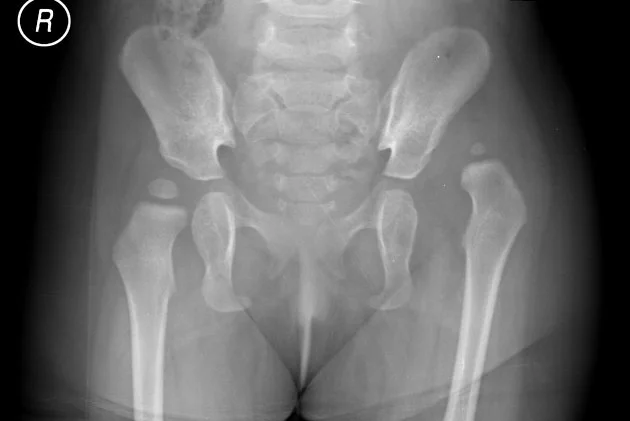Developmental Dysplasia of the Hips (DDH)
Developmental Dysplasia of the Hip (DDH) Patient Handout
Overview
Developmental Dysplasia of the Hip (DDH) is a spectrum of conditions related to the abnormal development of the hip joint in infants and young children. It ranges from mild acetabular dysplasia to complete dislocation of the hip.
Risk Factors
Several factors increase the risk of DDH, including:
Family History: A family history of DDH significantly increases the risk.
Breech Presentation: Infants born in a breech position are at higher risk.
Female Gender: DDH is more common in females due to increased ligamentous laxity and the affects of the mothers circulating hormones on the baby.
Firstborn Child: A tighter uterus in first-time pregnancies can contribute to DDH.
Oligohydramnios: Low amniotic fluid levels can limit fetal movement and affect hip development.
Macrosomia: Larger babies are at higher risk due to restricted space in the womb.
Swaddling Practices: Tight swaddling with the legs extended can contribute to hip dysplasia.
Screening and Diagnosis
Early detection of DDH is crucial for effective treatment. Screening methods include:
Clinical Examination: The Ortolani and Barlow manoeuvres are primary screening tests for newborn babies up to 6 months of age. They involve assessing the stability of the hip by gentle moving it in to different positions to see if the hip is stable in the socket
Ultrasound: Used for infants under 6 months to confirm diagnosis if clinical signs or risk factors are present.
Radiographs (X-rays): Used after 4-6 months of age when the femoral head begins to ossify.
Key diagnostic criteria include:
Positive findings on Ortolani or Barlow tests.
Limited hip abduction, or asymmetry in hip abduction.
Asymmetry in leg length or skin folds.
Ultrasonographic findings such as a shallow acetabulum or dislocatable hip.
Management
Management of DDH depends on the age of the child and the severity of the condition:
Newborn to 6 Months
Pavlik Harness: This soft brace holds the hips in a flexed and abducted position, allowing for normal development. It is the first line of treatment for infants under 6 months.
Rhino Brace, DB Brace or Turbingen Brace: These are alternatively bracing options used in specific situations that a Pavlik harness will not provide sufficient stability for the hip.
6 Months to 18 Months
Closed or Open Reduction and Spica Casting: If the Pavlik harness is ineffective or DDH is diagnosed later, a closed reduction (manipulating the hip back into place without surgery), open reduction (surgical procedure to place the hip back in to the socket) followed by spica casting is often used.
18 Months to 6 years
Open Reduction Surgery with Pelvic or Femoral Osteotomies: This may be necessary if non-surgical methods fail. It involves surgical repositioning of the hip joint, sometimes accompanied by osteotomies (bone cutting procedures) to reshape the hip socket.
6 years and older
Surgical options will depend on the severity of hip dysplasia and any previous treatment. For residual hip dysplasia with a concentric ball and socket there may the option of a periacetabular osteotomy (PAO) to reorientate the hip socket. For cases of dislocated hips or hips with associated arthritis the best course of treatment is often a total hip replacement in adulthood.
Long-Term Outcomes
With early and appropriate treatment, most children with DDH achieve normal hip function. However, untreated or late-diagnosed DDH can lead to long-term complications such as:
Early-Onset Osteoarthritis: Due to abnormal hip joint mechanics.
Leg Length Discrepancy: If the hip does not develop properly, or the hip devlops avascular necrosis as the result of treatment.
Hip Pain and Stiffness: Later in life, potentially leading to hip replacement surgery.
Avascular Necrosis: Disruption to the blood supply tothe femoral head as a result of treatment (both non-surgical and surgical). Depending on the age of treatment this can result in anything from a minor flattening of the femoral head to a ball that does not match the socket and is stiff and painful.
